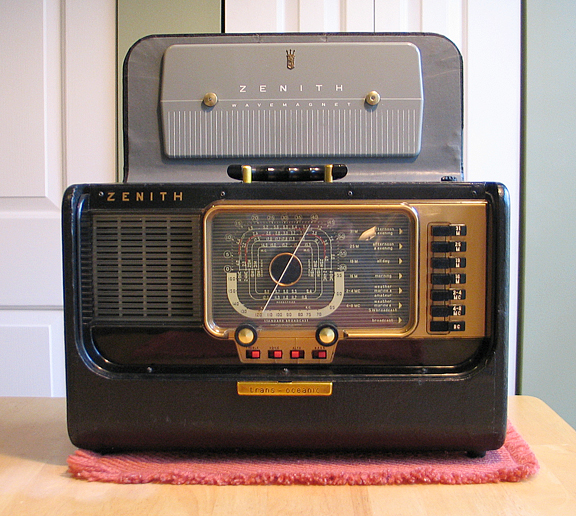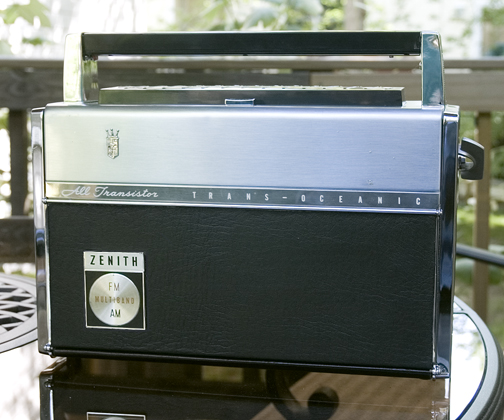Collecting and Restoring Zenith Trans-Oceanics Radios

Collecting and restoring tube and solid-state Zenith Trans-Oceanic radios is a serious and growing hobby, as evidenced by the large number of radios, radio parts, service literature, advertising memorabilia, and accessories sold on eBay and other online venues. Additionally, there are a number of online sources for original parts, reproduction parts, power supplies, and batteries. It is possible to acquire and restore any model Zenith Trans-Oceanic radio to like new condition, including an original or reproduction owner's manual, and a battery power supply. An internet search for Zenith Trans-Oceanic, or the item you need, will often return one or more sources.
Restoring a tube Zenith Trans-Oceanic is not particularly difficult, but the crowded chassis and the complex coil tower can be challenging. The first three solid state models, the Royal 1000s, 3000s, and 7000 are handwired and also relatively easy to restore. The final model series, the R7000, R7000-1 and R7000-2 use integrated circuits and are essentially modern solid state radios, which may not be particularly easy to restore unless one has experience with modern electronics. Serious collectors should consider purchasing a copy of the second edition of Zenith Trans-Oceanic,the Royalty of Radios, by John H. Bryant and Harold N. Cones.
Tube Trans-Oceanics
All models of the tube Zenith Trans-Oceanic radio use the same power source, the Zenith Z-985 battery. When operated on the Z-985 battery, the AC plug is inserted into a battery changeover switch, located on the chassis inside the back cover, except on the 600 series, where the switch plug is located outside the cabinet on the line cord escutcheon. The radio may be connected to AC power if a battery is not available.
The first two models of the Zenith Trans-Oceanic, the 7G605, and the 8G005 series, are somewhat different than the 500 and 600 series radios. The 7G705 and 8G005 radios use Loktal tubes and a rectifier tube to convert household AC to DC for the radio. Both have six tubes, one more tube than the later series, requiring a supplemental battery connected in series with the Z-985 battery. The 7G605 has a seperate oscillator tube, while the 8G005 radios has a push-pull audio amplifier, requiring two output tubes. The 500 and 600 series radios use a selenium rectifier, five miniature tubes, and a single-ended audio amplifier. The 600 series radios came with a phono input on the rear chassis apron.
The 7G605 Trans-Oceanic requires two D cells paralled in series with the Z-985 battery. The 8G005 series radios, requires a 1.5-volt Z-1 battery in series with the Z-985 battery. In either case, the supplementary batteries provide additional current to the tube filaments due to the extra tube present in each of those models. The 600 series radios use a Z-1 battery to power a dial light activated by a momentary contact slide switch on the front panel. The dial light circuit in the 600 series radios is not connected to the AC circuit and therefore only works if a Z-1 battery is connected.
Battery power is recommended for full-time operation of any Zenith Trans-Oceanic radio for best performance. Vintage radios, including the Trans-Oceanics, were designed at a time when few homes had more than a couple eletrical appliances and certainly none of the electronic devices such as smart phones, smart appliances, computers and routers that clutter homes today, all contributing noise to the AC lines and radio frequency interference (RFI). They lack the shielding and filtering of modern electronics to block out AC line interference and RFI. Your Trans-Oceanic will sound quieter without all that AC line noise, and should receive with greater sensitivity on battery power. The Z-985 AB Battery is no longer available. However, original Z-985 or other brand NEDA 400 sized battery boxes can be re-stuffed with modern alkaline batteries to make a working battery. A number of reproduction batteries and power supplies are available on the internet.
Only one model of the 7G605 Trans-Oceanic was produced, and production was halted due to WWII. Early 7G605 radios had a sailboat embroidered on the speaker cloth. Final models featured a B-17, and so the first model is sometimes called the "Bomber TO." The first post-war Trans-Oceanics, the 8G005 series, include the 8G005Y, 8G005YT, 8G005YTZ1 and 8G005YTZ2. The last two models used a miniature rectifier tube. The final two series of tube Trans-Oceanics, the 500 and the 600 models, are very similar. In any case, using the correct schematic will be helpful in determining the correct values of capacitors and resistors as well as proper voltages, which are particularly critical to ensure good performance and long life of the tubes. The 1L6 miniature tube used in the 500 and 600 models can be expensive. There are solid-state substitutes available on the internet for the 1L6 and other miniature tubes which work quite well.
There are only two models in the 500 series, the G500 and the H500. Restoring the H500 series radios can be a little confusing as there are five variations, but Zenith never gave any of these variations a distinct model identifier. Use the chart below to determine which H500 revision you have.
Introduction, baseline: Uses a 1S5 tube for the Det/AVC/AF. Has a dual-pin earphone jack.
Revision A: Uses a 1U5 tube for the Det/AVC/AF. Tube socket is wired differently from the 1S5. Also has a dual-pin earphone jack.
Revision B: Uses the 1U5 and earphone jack has been changed to a single 1/4-inch jack.
Revision C: Uses the 1U5 and has a single earphone jack. Low voltage switch was added for line voltages less than 110vac.
Revision D: Uses the 1U5, has single earphone jack and low voltage switch. A socket was added for an optional 50A1 ballast tube.
There are six models in the 600 series Trans-Oceanics and the differences are subtle. Each model in the 600 series was also available in a brown leather covering instead of the Black Stag covering most commonly seen. The last tube Trans-Oceanic, the B600, was produced in 1963.
The Bryant and Cones book, Zenith Trans-Oceanic,the Royalty of Radios, is especially helpful in sorting out the differences among the many Trans-Oceanic series and models. Schematics and service manuals, both originals and reproductions, are available online, and SAMS Photofacts are also available for many models, including the solid-state Trans-Oceanics.
Solid-State Trans-Oceanics
Just in time for Christmas of 1957, Zenith introduced the Royal 1000, the first Trans-Oceanic to use transistors instead of tubes. The solid-state models are much smaller than the tube models, but weigh about the same.
The solid state Trans-Oceanics use eight D cells to provide 12 volts DC. A ninth D cell provides power to the dial lights in the Royal 1000, 3000, and 7000 radios. Begining in 1964, AC adapters became available for certain models. Some solid state Trans-Oceanics have a positive ground and may be damaged by using an incorrect AC adapter.
Model 1000 variants include the 1958 1000D, which added a long-wave band, and the 1964 1000-1, which come with an AC adapter, but dropped the phono input.
 In 1962, Zenith introduced the Royal 3000, the first Trans-Oceanic to feature an FM band. The 3000 series radios are very similar to the 1000 series and share many cabinet components and parts. There are differences, however, and whether restoring a 1000 or 3000 series radio, it is important to find a schematic for the chassis number of your radio. Service manuals and schematics, including the very useful SAMS Photofacts, are available for most of the transistorized models.
In 1962, Zenith introduced the Royal 3000, the first Trans-Oceanic to feature an FM band. The 3000 series radios are very similar to the 1000 series and share many cabinet components and parts. There are differences, however, and whether restoring a 1000 or 3000 series radio, it is important to find a schematic for the chassis number of your radio. Service manuals and schematics, including the very useful SAMS Photofacts, are available for most of the transistorized models.
The 1000 and 3000 models resemble the expensive cameras of the era with lots of chrome and black leather or vinyl covering. Unfortunately, the chrome was not well applied, and most surviving radios will have some pitting, bubbling, and flaking of the chrome. The whip antenna, or Waverod, was stored inside a rather fragile plastic carrying handle. Many of the handles cracked over time, and these models should always be supported by one hand underneath when carried.
In 1969, Zenith introduced a completely re-designed and updated solid-state Trans-Oceanic, the Royal 7000 series. In addition to the FM band, a VHF NOAA weatherband was added. Two additional variations of this model were introduced, the 7000-Y, in 1970, and the most popular model with collectors, the D7000Y, in 1972. The D7000Y had a tunable weather band.
The last series of Trans-Oceanics, the R-7000 series, was introduced in 1979. There are three model variants, the original R-7000 from 1979, the R-7000-1 from 1980, and the R-7000-2, from 1981. The final model was assembled in Taiwan from U.S. made parts, and is the most desirable, as the two earlier variants suffer from a flawed tuning mechanism. The R-7000-2 used a gear drive.
All of the solid-state Trans-Oceanics are excellent radios with very good audio quality. It is not unusual for mint, new-in-box examples of the solid state Trans-Oceanics to show up on eBay from time to time, but usually carry premium prices.
Use Your Browser's Back Button to Return to Previous Page
Home
 In 1962, Zenith introduced the Royal 3000, the first Trans-Oceanic to feature an FM band. The 3000 series radios are very similar to the 1000 series and share many cabinet components and parts. There are differences, however, and whether restoring a 1000 or 3000 series radio, it is important to find a schematic for the chassis number of your radio. Service manuals and schematics, including the very useful SAMS Photofacts, are available for most of the transistorized models.
In 1962, Zenith introduced the Royal 3000, the first Trans-Oceanic to feature an FM band. The 3000 series radios are very similar to the 1000 series and share many cabinet components and parts. There are differences, however, and whether restoring a 1000 or 3000 series radio, it is important to find a schematic for the chassis number of your radio. Service manuals and schematics, including the very useful SAMS Photofacts, are available for most of the transistorized models.